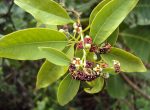 Also called Indian sandalwood, this semi-parsitic deciduous tree is native to southern India and Southeast Asia where it grows mostly in dry deciduous and scrub forests but can also be found in wet forests and beach areas. It is a member of the Santalaceae, a widely distributed plant family that also includes mistletoe. Plants attach by haustoria to the roots of other trees that provide light shade as well as micronutrients, nitrogen, phosphorus, and potassium. Growing 13-66′ tall, the trees have reddish-brown, dark brown, dark gray to black bark that is smooth when young but develops vertical cracks with age. The slender dropping branches carry thin, opposite leaves that are ovate to lanceolate and 1-8″ long. The leaves are bright green, shiny above, pale yellow green below, and have rounded or pointed tips and conspicuous reticulate veining. The small purplish-brown flowers with 5 tepals appear in terminal or axillary clusters from March to April in its native habitat in India. The fruit is a small blackish-purple beaked drupe with one seed. Photo Credit Wikimedia
Also called Indian sandalwood, this semi-parsitic deciduous tree is native to southern India and Southeast Asia where it grows mostly in dry deciduous and scrub forests but can also be found in wet forests and beach areas. It is a member of the Santalaceae, a widely distributed plant family that also includes mistletoe. Plants attach by haustoria to the roots of other trees that provide light shade as well as micronutrients, nitrogen, phosphorus, and potassium. Growing 13-66′ tall, the trees have reddish-brown, dark brown, dark gray to black bark that is smooth when young but develops vertical cracks with age. The slender dropping branches carry thin, opposite leaves that are ovate to lanceolate and 1-8″ long. The leaves are bright green, shiny above, pale yellow green below, and have rounded or pointed tips and conspicuous reticulate veining. The small purplish-brown flowers with 5 tepals appear in terminal or axillary clusters from March to April in its native habitat in India. The fruit is a small blackish-purple beaked drupe with one seed. Photo Credit Wikimedia
The Hebrew words ahalim and ahaloth are usually translated aloe but scholars think that the aloes of the New Testament are true aloes, Aloe succotrina, while those of the Old Testament are Santalum album (white sandalwood) Aquilaria agllocha (eaglewood), or A. ovata. White sandalwood has been highly valued for its sweet fragrance and use as a medicine, perfume and incense in the East for at least 4,000 years and may have been more accessible to the people of Palestine than eaglewood.
Psalms 45:8 (NIV) The greatness of an anointed (but unidentified) king is extolled.
“All your robes are fragrant with myrrh and aloes and cassia; from palaces adorned with ivory the music of the strings makes you glad.”
Proverbs 7.17 (NIV) Solomon tells a story of seduction in which an immoral woman lures a young man to her bed.
” I have perfumed my bed with myrrh, aloes and cinnamon.”
Song of Songs 4.14 (NIV) The bridegroom describes the garden of his beloved.
“nard and saffron, calamus and cinnamon, with every kind of incense tree, with myrrh and aloes and all the finest spices.”
White sandalwood likes full sun and fertile, moderately moist, well-drained, slightly acidic in USDA Hardiness Zones 10-11 but tolerates some shade and produces the best oil in dry rocky soil. Propagation is by seed, branch cuttings and cleft grafting. White sandalwood is valued for fine carving and cabinet work, as a food flavoring, and as an ornamental. The trees are very long lived but harvest is possible only after many years.
The genus name, Santalum, is from the Greek santalon meaning sandalwood. The specific epithet, alba, is the Latin word for white and refers to the bark.